Assessing The 2018 Battle For Control Of Congress
The early numbers in the battle to control Congress look good for Democrats, but there are are a number of caveats to keep in mind.
In one of the most recent assessments of the state of the race for control of Congress in next year’s midterm elections, David Wassermann of the Cook Report finds signs that the GOP majority could be in trouble:
If it wasn’t already clear, last Tuesday’s election results confirmed a political atmosphere that would seriously endanger the House GOP’s majority in 2018. In Virginia, turnout was up 20 percent over 2013 in localities won by Hillary Clinton, compared to 13 percent in localities carried by President Trump. Not only did Democrat Ralph Northam outperform pre-election polls, Democrats shocked by nearly winning control of Virginia’s House of Delegates.
In blue-leaning delegate seats, GOP incumbents’ personal appeal failed to insulate them from voters’ anti-Trump mood, even against weak, under-funded and self-described socialist opponents. Republicans held onto just two of their 17 seats in districts Clinton carried, and are headed to a recount in a third. The results suggest Northern Virginia Rep. Barbara Comstock (VA-10) is the single most vulnerable GOP incumbent in the country.
Republicans push back by arguing that Virginia’s proximity to DC makes it a uniquely anti-Trump place, nowhere near as many House GOP incumbents sit in districts as pro-Clinton as those Democrats won last Tuesday and that Democrats failed to make much progress in Trump territory. There’s some merit to each of those points.
But, Virginia’s Democrats didn’t seriously compete or spend money in most Trump-carried delegate districts. And in the few where they did, they tended to modestly outperform Clinton. Democrats pick up a Virginia Beach seat Trump carried by a point, and came within less than 150 votes of winning two other Trump seats. In Loudoun County, Democrat Tia Walbridge spent over $264,000 and took 45 percent in a seat where Clinton took just 40 percent last fall.
Taken together with results from four 2017 House special elections in red districts, where Democrats outperformed Clinton anywhere from one point (GA-06) to 13 points (KS-04), the balance of evidence suggests Democrats would be the ever-so-slight favorites to reclaim the House if the elections were held today
(…)
At this point in 2006 and 2010, it wasn’t yet obvious that the House majority was at serious risk. As a result, the parties in control didn’t suffer historically large numbers of retirements. Today, we’re still almost a month away from the first filing deadlines in Illinois and Texas. Over the next few months, many Republicans will weigh whether it’s worth raising $3 million or more to face the wrath of Democrats, and in some cases, the likes of Steve Bannon as well.
Moreover, tough votes like yesterday’s on tax reform continue to give Democrats new avenues to link GOP members to unpopular proposals and leaders. Democrats are increasingly confident Speaker Paul Ryan will turn into a more effective bogeyman than either Trump or Nancy Pelosi, because he’s disliked not only by Democrats but by much of Trump’s base — a constituency GOP members badly need to motivate and turn out to win their races.
In the same report, which was actually issued last week, Wassermann also charges the outlook in seven key districts, all in favor of Democrats. Most of these districts consist of seats that are currently held by Republicans but which Hillary Clinton by varying margins in the 2016 Presidential election, however, it’s an indication of the kind of rocky waters that Republicans are likely to face over the next eleven months as we head toward what is likely to be a particularly hard-fought midterm election cycle that could have serious implications for the remaining years of President Trump’s first four years in office. Further evidence of the current state of the race can be seen in the Generic Congressional Ballot, which gives an indication of whether voters are inclined to vote for a Republican or a Democrat in their vote for the House of Representatives in the coming midterm. According to RealClearPolitics, the average for that ballot shows that an average of 47.6% of respondents say they’re likely to vote for a Democrat and 36.9% say they’re likely to vote for a Republican, giving Democrats an average 10.7% lead at the present time. RealClearPolitics also shows President Trump continuing to be at a deficit with 38.3% approving of his job performance and 57.1% disapproving. Congressional Job Approval is even worse, with just 13.0% approving of the job Congress is going and 73.4% disapproving. At Pollster, the numbers are tighter, with the Generic Congressional Ballot there showing an average of 40.6% saying they are likely to vote Democratic and 34.6% saying they are likely to vote Republican and the President’s Job Approval at 39% approve and 56% disapprove. Over at FiveThirtyEight, where the averages are weighted based on pollster reliability and other factors, the Generic Congressional Ballot shows 48.1% of respondents saying they are likely to vote for a Democrat and 37.7% saying they are likely to vote for a Republican and the President’s Job Approval numbers stand at 38.1% approve and 55.8% disapprove. In other measurements of the mood of the country, the RealClearPolitics average of the bellwether Right Track/Wrong Track poll shows 30.7% saying the country is on the right track and a 61/4% saying it is on the wrong track.
We can also see the general trend in the Generic Ballot Chart from RealClearPolitics:
And the Congressional Ballot Chart:
Taking all of these numbers together, things are certainly looking good for the Democrats next year, at least as far as the House of Representatives is concerned. The combination of a historically unpopular Republican President, an unpopular Congress, although it’s worthing noting that overall job approval for Congress has been bad for some time and that hasn’t stopped incumbents from being re-elected, and a nation where an overwhelming number of voters think that the country is on the wrong track are all signs that point toward at least some gains by the party out of power. It’s worth noting, of course, that we see gains by the opposition in the first midterm of a new President’s term in office. The only recent exception to that rule game in the 2002 midterms, when Republicans actually gained a seat in the House and gained two seats in the Senate, giving them control of that body after losing it a year earlier to due to the decision of Vermont Senator James Jeffords switching parties in the early month of George W. Bush’s Administration. That anomaly, however, can be somewhat dismissed based on the fact that the election came just over a year after the September 11th attack, during the early part of the war in Afghanistan, and at a time when President Bush’s job approval numbers were still at a high level. Given that, it’s to be expected that Democrats will have at least some gains next year, the question is what the extent of those gains will be.
All that being said, there are several caveats to keep in mind that could have a real impact on the race for control of Congress.
Right off the top of the list, of course, is the fact that gaining seats in the House does not necessarily mean winning control of that body. Presently, Republicans currently hold 240 seats and Democrats currently hold 194 seats, with one seat being vacant due to the resignation of Republican Congressman Tim Murphy of Pennsylvania back in October. In order to gain control of a fully-staffed House, Democrats would need to win at least 24 seats in next year’s election while Republicans could stand to lose as many as 22 seats and still have a razor-thin majority. This would essentially require a wave election on the scope of what we saw in 2006 or 2010, which we haven’t really seen in the past seven years. While it’s certainly possible that this could happen, there are a number of factors that could make it difficult for Democrats to gain the traction they need to win control.
First of all, of course, is the fact that a combination of outright Gerrymandering and an increase in political polarization mean that there is a relative lack of real battleground districts in the House, and certainly, fewer than there used to be. This makes it hard for an opposition party to make real gains in the membership of the House absent the combination of a number of factors that push the mood of the country toward tossing out the party in power in Congress. Additionally, a wave election generally requires that the Congressional race becomes nationalized rather than one where voters are focusing on their individual members of Congress. In the first case, it becomes far more likely that an opposition party can gain the traction it needs to take control of either the House or the Senate. If voters are concentrating more on their individual member of Congress, though, historic incumbent re-election rates suggest that gaining control could prove to be difficult. Finally, of course, there’s the simple fact that we’re still nearly a year away from Election Day in 2018. There are any number of things that could happen over the next 351 days that are likely to have a serious impact on how voters behave when they get to the voting booth.
Over in the Senate, the prospects for Democrats grabbing control of the upper chamber of Congress are similarly mixed and arguably far more difficult. Of the 33 seats up for re-election in the Senate, only eight are held by Republicans and the vast majority of those are in solidly red states where it’s highly unlikely that a Democrat would have a chance of winning. Of those eight, in fact, only two seats are currently deemed to be vulnerable or potentially vulnerable. The first such seat is Dean Heller’s in Nevada, which was won by Hillary Clinton in 2016 by roughly two percentage points and where a Democrat won the Senate seat of retiring Senator Harry Reid. Current polling shows Heller narrowly trailing both a Generic Democrat and the Democrat most likely to win the election. Additionally, Heller is being challenged by Danny Tarkanian, a candidate with backing from the Tea Party and other grassroots organizations on the right, and current polling on that race shows Tarkanian with a narrow lead. The other race where Republican control may be in doubt is in Arizona, where Senator Jeff Flake has announced that he will not stand for re-election. Depending on who ends up winning the Republican nomination, Democrats could have a shot at winning the seat. Even if Democrats won both of these seats, though, that would turn the Senate membership into a 50-50 split between the parties, which would result in Republican control of the body thanks to the tie-breaking vote from the Vice-President.
In addition to a dearth of pickup opportunities in the Senate next year, there is one big reason why Democrats could face an uphill battle in the Senate. While Republicans only have to worry about defending eight seats in the Senate next year, Democrats will have to defend 28 seats. While many of those are in solidly blue states that the GOP is unlikely to win, at least nine of them are in states that are either solidly red states or in states that Donald Trump won in 2016. Some of these seats, such as Debbie Stabenow’s in Michigan, are probably secure regardless of who Republicans put up. Others, however, are potentially at risk, with the most likely of those being the seats held by Jon Tester in Montana, Heidi Heitkamp in North Dakota, and Claire McCaskill in Missouri. Other vulnerable Democrats include Joe Donnelly in Indiana, Tammy Baldwin in Wisconsin, and Bill Nelson in Florida. Even if Republicans win only one or two of these seats, it would offset whatever limited gains Democrats are able to make, and could even result in the GOP increasing its majority.
All of this goes a long way toward saying that the numbers right now do look favorable to Democrats, but it’s still far too early to say where we might be headed next year. Much of that will depend on the mood of the country, the state of the economy, outside factors such as the status of the Russia investigation, developments overseas and, of course, things that we can’t predict as of yet. Finally, it also depends on what happens inside the Democratic Party, where we’re currently seeing a battle for control in which the 2016 race between Hillary Clinton and Bernie Sanders still have not totally healed and where it’s unclear what agenda the party will present to the country outside of being the anti-Trump party. All of that wil go a long way toward determining who controls Congress in January 2019.

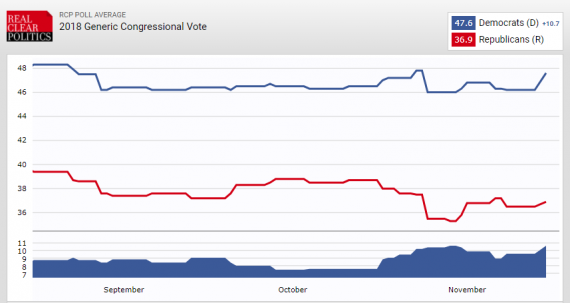
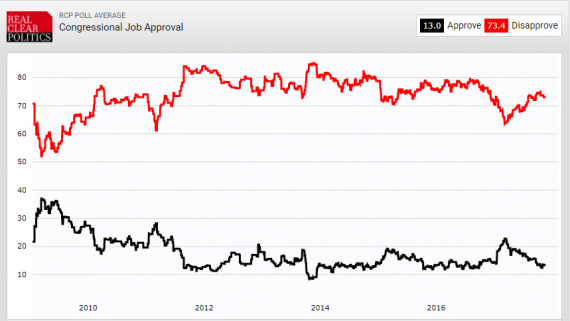

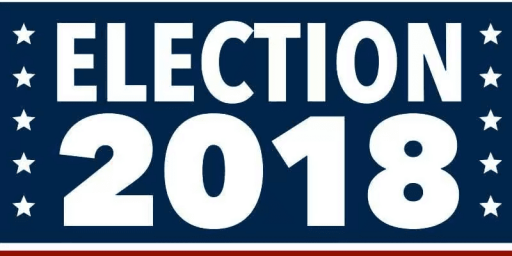
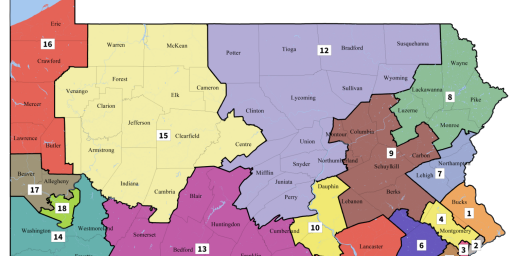

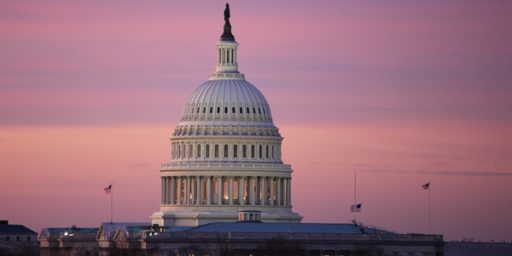

That. Trump won by running against the REPUBLICAN establishment. Democrats certainly ought to be able to run against the Republican establishment. McConnell isn’t exactly widely loved either.
Republicans pulled off a pretty effective sleight of hand trick. They changed the meaning of “establishment”. It should mean Koch Bros and the GOPs who have dominated politics since the 80s. Somehow they’ve made it mean underpaid assoc profs and Democrats. That trick gets harder every month GOPs control both houses of Congress, the Supremes, and the WH.
And send money to Iron Stache.
Too many wild-cards still out there to even consider the election yet.
What happens in Alabama?
What happens with the Tax Cut for the Rich?
What happens with the economy? The Tax Cut for the Rich threatens to completely re-frame the economics of housing…are we going to have another real estate driven recession when people realize their largest investment is worth 20% less than it used to be?
What happens with Mueller and the Russia investigation?
What fvcked up thing is Cheeto-Dick going to do, that we can’t even imagine yet?
It’s been a messed up year, and that shows no sign of abating. Anything can happen in the next 11-1/2 months.
“Much of that will depend on the mood of the country, the state of the economy, outside factors such as the status of the Russia investigation, developments overseas and, of course, things that we can’t predict as of yet.”
This is normally were I’d be worried that Trump will drag us into a war with either North Korea or Iran in order to benefit from a ‘rally around the flag.’ But, since Trump (1) actively dislikes a large chunk of the GOP congress and is disliked by them in turn, and (2) has the foresight and planning ability of a particularly inbred Golden Retriever….I’m thinking there probably won’t be a war before 2018, but he’ll try to cobble something together right around primary season for 2020….
The time is right for a total change in political structure – a “reformation” scale change: one political party that is made up of several divisions that would represent conservative, center, progressive, populist, and liberal platforms and philosophies! Think about it – Paul Ryan, Rand Paul, John Casich, Hillary Clinton, Elizabeth Warren, Nancy Pelosi, and Alan Keyes in the same party! Imagine what all could get accomplished! All this political fueding, bickering, influence, and dirty politics would be a thing of the past!
It turns out that if your main policy goal is pissing off libtards you also end up energizing them. And without a target to bring down at a national level — no Clinton fatigue, or email “scandals” — it’s going to be hard to depress that vote at the last minute.